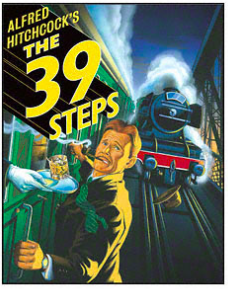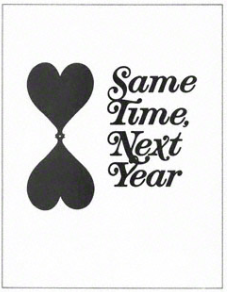 There was a time, children, not so very long ago, when hit plays ran much longer than than 131 performances. Why 131? Because in the last ten complete Broadway seasons, that’s the average of how long a play – new or revival – ran. Yet, out of 313 plays in that decade, only 21 plays ran for 200 performances or more, and only seven ran for 300 performances or more. No play in the past decade topped 800 performances, as The 39 Steps stopped climbing at 794 performances and War Horse headed for the stables at 741.
There was a time, children, not so very long ago, when hit plays ran much longer than than 131 performances. Why 131? Because in the last ten complete Broadway seasons, that’s the average of how long a play – new or revival – ran. Yet, out of 313 plays in that decade, only 21 plays ran for 200 performances or more, and only seven ran for 300 performances or more. No play in the past decade topped 800 performances, as The 39 Steps stopped climbing at 794 performances and War Horse headed for the stables at 741.
Going back 40 years ago, specifically to the 1974-75 season, out of the 42 plays produced on Broadway that year alone, four plays ran over 200 performances, three ran over 400 performances, one ran a hair under 600 performances, and two ran well past 1,000 performances. Those last two plays, FYI, were Same Time Next Year and Equus.
For perspective, a year of performances, assuming 52 weeks at eight shows a week, is 416 performances. So that means in the past 10 years, only five shows ran for more than a year. In 1974-75 alone, four did. What happened?
 Well, based on studying the past decade, and then looking at the prior 25 years at five year intervals, it seems the average length of runs for a play hasn’t changed much: from 146 then to 131 now, all of two weeks variance. As Ken Davenport pointed out, new plays run longer than revivals; on average, the difference between them over the past 10 years is about five weeks.
Well, based on studying the past decade, and then looking at the prior 25 years at five year intervals, it seems the average length of runs for a play hasn’t changed much: from 146 then to 131 now, all of two weeks variance. As Ken Davenport pointed out, new plays run longer than revivals; on average, the difference between them over the past 10 years is about five weeks.
One key factor is that when you go back to the days when plays ran for a year or two or more, there were many more shows that ran only a handful of performances. It wasn’t uncommon for show to play two or three previews, open, and shutter almost instantly. The long-runners were balanced by the fast-closers. With extended preview periods now, the idea of a show that doesn’t manage to play for at least a month is unheard of; even Elling performed 29 times and The Performers exposed themselves 30 times.
 Today, when the solid base of fixed runs at Roundabout, Lincoln Center and Manhattan Theatre Club accounts for a significant amount of the dramatic activity on Broadway, relatively short runs are more common. Place them alongside the now common star-driven limited runs of 13 to 17 weeks, and the 131 performance average makes perfect sense. The average run per season only varied significantly once in the past decade, in the 2007-08 season, thanks primarily to The 39 Steps and August: Osage County (666), with assists from Boeing Boeing (296) and November (238).
Today, when the solid base of fixed runs at Roundabout, Lincoln Center and Manhattan Theatre Club accounts for a significant amount of the dramatic activity on Broadway, relatively short runs are more common. Place them alongside the now common star-driven limited runs of 13 to 17 weeks, and the 131 performance average makes perfect sense. The average run per season only varied significantly once in the past decade, in the 2007-08 season, thanks primarily to The 39 Steps and August: Osage County (666), with assists from Boeing Boeing (296) and November (238).
So as much as we might want to complain about the brevity of plays’ runs on Broadway, the minor difference in average runs suggests that things haven’t really changed all that much. Even when we go back into the 1970s, when it wasn’t uncommon to find 40 or more new plays in a season, the average held.
In an era where hit musicals run longer than ever, why are hit plays running shorter? People are quick to blame the short, star-driven runs of plays, where brief runs can gross more than $1 million a week and generate profits without overstaying their welcome – and that’s not untrue. But the long-runners nowadays are plays that are launched without stars – The 39 Steps, War Horse, August: Osage County, Peter and The Starcatcher. Only one significant long-runner in the past decade was star-driven – God of Carnage – and therein lies a big catch.
 Long-running plays are those which either aren’t conceived as star vehicles or, even when star driven, take the leap and make cast changes, or even introduce entirely new casts. There were three casts for Carnage, and while the presence of James Gandolfini undoubtedly was key to launching the play, it proved (not unlike playwright Yasmina Reza’s Art) that a play could become a hit even without maintaining its original cast. In the case of August: Osage County, cast replacements were actually better known than those who originated the roles: Deanna Dunagan may have won a Tony, but even regular theatregoers were probably more familiar with her successors, Estelle Parsons and Phylicia Rashad.
Long-running plays are those which either aren’t conceived as star vehicles or, even when star driven, take the leap and make cast changes, or even introduce entirely new casts. There were three casts for Carnage, and while the presence of James Gandolfini undoubtedly was key to launching the play, it proved (not unlike playwright Yasmina Reza’s Art) that a play could become a hit even without maintaining its original cast. In the case of August: Osage County, cast replacements were actually better known than those who originated the roles: Deanna Dunagan may have won a Tony, but even regular theatregoers were probably more familiar with her successors, Estelle Parsons and Phylicia Rashad.
It would appear that long-running plays have fallen victim to the conventional wisdom that only stars are stars, that plays can’t be stars. But even if we were to accept that as true, look at what Equus managed: Anthony Hopkins (who was far from a star in those days) was succeeded by, among others, Anthony Perkins, Leonard Nimoy and Richard Burton. Yes, that’s right – Burton was a replacement. Though not in the years I selected, let’s also remember that The Elephant Man originally starred the unknown Philip Anglim, who was followed by, among others, David Bowie. I would put it to casting directors to answer the question of whether stars are no longer willing to succeed others on Broadway, at a time when ostensibly there are more name actors than ever seeking the professional credibility that a Broadway stint can bring. Or is it that profit margins are so low that producers aren’t willing to risk installing a new star or new cast?
With the kind of money at risk on Broadway these days – a play will cost $3 million or more – there is an understandable desire to minimize risk. But in the process, plays have been minimized as well. The length of plays’ runs, and the size of the theatres they play in, certainly explain why 80% of Broadway attendees see musicals. But the data, both old and new, bears out that once a play succeeds, provided the success is based on something more than just the celebrity of a cast member, plays can still be coaxed into longer runs, allowing non-musical pieces to perhaps claw back a bit more of Broadway. Maybe we’ll never return to the days when “the play’s the thing” on Broadway, but perhaps they can be more of a thing than they’ve been lately.
* * *
Note: The years cited prior to the 2004-2005 season are a sampling of the period, not complete (I have neither sufficient time nor any staff to research as much as I’d like). The plays cited from that period are not necessarily the longest runners ever (Gemini (1,819) and Deathtrap (1,793) are among the plays that outran them), but simply happened to fall within the years selected during the defined span of time. Even longer running plays date back to the days of Tobacco Road (3,182 performances) and Life With Father (3,224), but the fundamental changes in Broadway since that time render any comparison uninstructive. There have been changes since the 70s as well, but it is not so far in the past as to be invalid for comparison’s sake.



